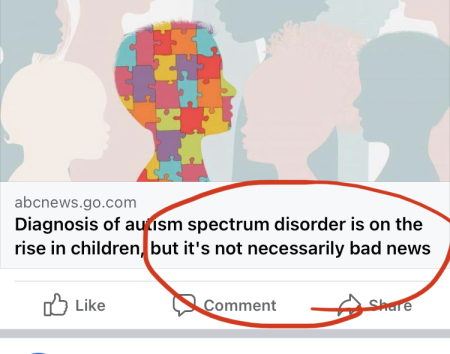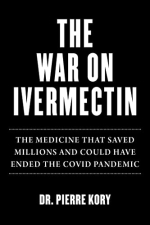It’s Not So Bad
Decorum prevents me from writing what we are all thinking. Until April, then all bets are off. Gloves too.
By Anne Dachel
Autism one in 36 (one in 22 boys) It’s all good
By now anyone who’s interested has seen the latest upswing in the autism rate. As usual, the underlying message is, it’s nothing to worry about.
No one ever talks about more kids actually having autism. That’s long been THE REALLY BIG LIE ABOUT AUTISM, something I’ve expressly written about over the years.
Here once again are references to greater awareness, along with diagnosing delays due to COVID, more girls being detected, more minority children now being diagnosed, and “demographic differences”—although none of this could explain the latest leap from one in 44 to one in 36.
USA Today: quoted Dr. Andy Shih, chief science officer of Autism Speaks, who conveniently took credit for the new numbers.
Shih: ‘This increase is really fueled by us doing a much better job in identifying minority children with autism.’
I will give USA Today’s Karen Weintraub credit for also citing Dr. Walter Zahorodny in her story.
“No one really knows what’s driving autism rates higher,” said Zahorodny, also director of the New Jersey Autism Study and an associate professor at Rutgers University.
For years, people have pinned rising rates on a variety of causes, including improved awareness, reduced stigma, re-labeling of kids, aging parents, low-birth-weight babies or C-section deliveries. Though they all may contribute, Zahorodny thinks something else from our contemporary environment is driving the rates.
“This is a true increase,” he said. “It constitutes a major public health crisis.”
Weintraub even quoted Zahorodny in the headline of her story: ‘Public health crisis’: Autism rates rise again, with 1 in 36 children diagnosed, but in the final analysis, she lets Dr. Shih dismiss it all.
Improved services definitely help drive rates up, Shih said, which is a good thing.
“We’re definitely seeing there’s a greater capacity among caregivers and families not only to recognize and to understand what autism is but also to navigate the system,” he said. “I think that’s a huge improvement and progress in our community.”
Weintraub, like everyone else in the media, will never ask hard questions:
Questions for Dr. Shih: Will you keep getting better and better at diagnosing until the rate is one in 22 (like the current rate in California)? How long before you finally get it right?
Why can’t you find the same rate of autism among middle aged and elderly Americans?
Questions for Dr. Zahorodny: If this is ‘a true increase,’ what are you doing about it? What in the ‘contemporary environment’ is destroying the developmental health of so many children?
How long are experts going to scratch their collective heads and merely calculate the damage?
Other faithful minions in the media were quick to dismiss any real increase.
UPI: Public health experts noted that the shifts may reflect improved screening, awareness and access to services among historically underserved groups.
AAP: We can’t say for sure, but we suspect this is due to increased awareness leading to more children being identified with autism,” Karen Remley, M.D., M.B.A., M.P.H., FAAP, director of the Centers for Disease Control and Prevention’s (CDC’s) National Center on Birth Defects and Developmental Disabilities, said in a press conference.
CBS Philadelphia: “A lot of the increase is likely due to changes in practice, improvements in early detection, availability of services,” CDC’s child development and disability branch chief Matt Maenner said.
CNN: But according to the CDC, this long-term trend has “largely been interpreted as improvements in more equitable identification of (autism spectrum disorder), particularly for children in groups that have less access or face greater barriers in obtaining services.”…
In recent years, good progress had been made in early detection of autism – an earlier CDC report found that children born in 2014 were 50% more likely to receive an autism diagnosis or special education by age 4 than those born in 2010.
NBC News: Experts attributed the change to improved screening and autism services for all kids, and to increased awareness and advocacy for Black and Hispanic families.
This is a story that will quickly die
The news came out on Thursday, March 23rd, and I’m sure it will no longer be mentioned by Monday. The new rate will lost in the gala celebrations coming up with AUTISM ACCEPTION MONTH in April. (Note that it’s no longer “autism awareness” as it’s traditionally been titled.)
Sadly, accepting autism, whatever the rate increase, is the only thing left for us to do.
Anne Dachel is Media Editor for Age of Autism.
###
By Edward Dowd
Follow Ed Dowd on Twitter for in depth coverage of the problems facing the banking & capital markets today. @DowdEdward
The book begins with a close look at the actual human reality behind the statistics, and when you see the people who are represented by the dry term Excess Mortality, it’s difficult to accept so many unexpected sudden deaths of young athletes, known to be the healthiest among us. Similarly, when lots of healthy teenagers and young adults die in their sleep without obvious reason, collapse and die on a family outing, or fall down dead while playing sports, that all by itself raises an immediate public health concern. Or at least it used to.
Ask yourself if you recall seeing these kinds of things occurring during your own life—in junior high? In high school? In college? How many times in your life did you hear of a performer dropping dead on stage in mid-performance? Your own life experience and intuition will tell you that what you’re about to see is not normal.
Or at least it wasn’t normal before 2021.
By Dr. Pierre Kory
Follow Dr. Kory on Twitter here. Support is so important.
Big Pharma and health agencies cry “Don’t take ivermectin!” A media storm follows. Why then, does the science say the opposite?
Ivermectin is a dirty word in the media. The drug has been derided and declared useless. Doctors have earnestly recorded pleas asking those afflicted with COVID-19 not to take the drug. But why?
The War on Ivermectin is the personal and professional narrative of Dr. Pierre Kory, the co-founder of an expert group of physicians’, and his plight to alert the world of his group’s identification of ivermectin as a highly-effective, life-saving, widely available generic medicine with an obvious ability to end the global pandemic. In this book, Dr. Kory details all the personal attacks, professional setbacks, and concerted, corrupt, and highly effective actions which influenced the world’s major health agencies and medical journals to dismiss and deny it’s efficacy.
![]()
For the rest of this article please go to source link below.



